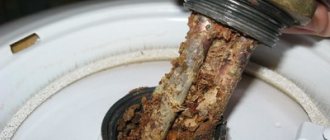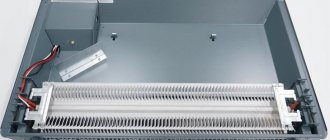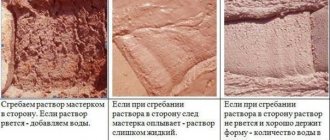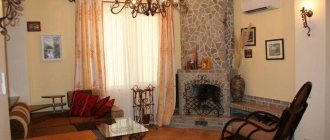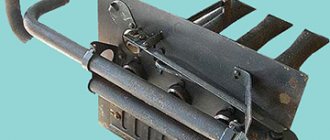Which convector to choose? How does a convector work? How to choose the power of the convector? What is the difference between an electronic and a mechanical thermostat in convectors? How and where to install the convector?
The question of how to warm up a country house or other country property sooner or later faces any owner who goes out into nature. Changeable weather and cool climate force us to use heating even in summer, not to mention the autumn-spring period, and even more so in winter. One way to heat a summer house is to use electric heaters. There are several types of electric heaters: electric convectors, oil heaters, infrared heaters, heat fans and guns. Each of them has its own advantages and disadvantages:
- Fan heaters are electric heaters that use a fan to force air flow through a high-temperature heating element. Fan heaters with a power of over 3 kW are called heat guns. As a rule, they have several fan speeds and several power levels. If you need to quickly warm up a room, then a fan heater or heat gun is an indispensable device . Advantages: compact dimensions; light weight and mobility; low cost and high speed of heating the room. Disadvantages: noticeable noise generated by the fan; dry the air very much; high fire hazard and inadmissibility of autonomous and long-term operation (they cannot be left unattended). Staying for a long time (let alone sleeping) in a room that is heated by a heat gun is not comfortable.
- Infrared heaters are electric heaters that heat not the air in the room, but the surfaces of objects in front of it . Heating occurs due to infrared radiation. There are low-temperature or long-wave (heating element temperature 200-250°C) and light spectrum (high temperature ~600°C). Advantages: minimal inertia (it is immediately warm in the operating area of such a heater); Due to the fact that it is not the air that is heated, but the surfaces of objects, in large rooms (warehouses, garages) or rooms with poor thermal insulation, you can organize a comfortable “warm” zone. Very convenient for heating “semi-open” rooms - verandas, etc. Disadvantages: the main disadvantages follow from the advantages - they warm only in front of themselves. When you leave the heating zone, you immediately find yourself in the cold. The second minus is that objects that are closer to the infrared heat up more strongly, while those further away heat up less. That is, for example, when using ceiling IR heaters, the head will always heat up more than the legs, which is completely uncomfortable.
- Oil heaters are very popular electric heaters. Essentially an oil-filled mobile battery. As a rule, they have several power levels. Advantages: 1. Low price (for simple models without fans, convection cases, etc.). 2. Mobility (as a rule, models are equipped with caster wheels). 3. Inertia (this is both an advantage and a disadvantage) an oil heater takes a long time to heat up, but also gives off heat for a long time. Disadvantages: 1. Inertia. 2. Local heating: when using models without convection housings or fans, such a heater heats the air around it; at the other end of the room its effect is practically not felt, and more advanced models are much more expensive. 3. Weight: even a small model can weigh about 10 kg. 4. Fire hazard: the oil that fills the heater is flammable. 5. High temperature of the heater surface: it can be more than 90C - you can get burned.
- Electric convectors are heaters whose operating principle is based on natural convection. They are a hollow body with a heating element located at the bottom. Due to convection, cold air enters through the lower part of the convector, heats up, and exits through holes in the upper part of the housing. Advantages: 1. Low inertia (warm air begins to enter the room 20-30 seconds after turning on the convector). 2. Possibility of autonomous operation (can work unattended for a long time, for example, maintain a slightly positive temperature in the room during the week in order to quickly warm up the room on the weekend). This applies to convectors with a closed heating element. 3. Comfortable heating of living spaces. Disadvantages: 1. Price (high-quality models made in Europe can be quite expensive. It is worth noting that this disadvantage is common to all types of heaters) 2. They dry out the air (in principle, like any heating device, even central heating radiators). 3. By default, they are intended for stationary installation (almost all convectors by default come complete with a stationary wall mount; casters/wheels/legs must be purchased separately).
Where to install the convector?
It is recommended to install electric convectors permanently, under a window (like central heating batteries), thus creating a thermal curtain. It is desirable that the convector completely covers the window opening. The convector is hung on the wall at a height of 8-12 cm from the floor. There should be 12-15 cm from the top edge of the convector to the window sill. In bathrooms, showers, etc. the convector must be located so that the controls are inaccessible to the person taking a shower or bath. The socket into which the convector is connected must not be placed above the heating device.
If it is not possible to install the convector under a window, you can hang it in any other place. Convectors intended for mobile installation are equipped with legs or roller wheels, and also, without fail, a tipping sensor. Please note: some convector models cannot be installed on legs or rollers!
What it is
An electric heater is especially relevant in dachas and country houses. Of course, it’s good when the house already has a stationary heating system. But an electric heater will help reduce the load on the existing heating system or, in emergency cases, replace it.
There are other options for heating the room:
- Oil heater;
- Fan heater.
But if you need a device that will:
- Safe;
- Easy;
- Compact;
- Quiet.
The most preferable option is a convector.
It is equipped with a reliable housing that covers the heating elements located inside. The air, passing through the lower special openings, is heated by heating elements.
According to the laws of physics, heated air goes up through the upper openings, heating the surrounding space, according to the principle of heat convection.
This is where it differs from devices that operate on the principle of radiating heat.
Structurally, the heater consists of:
- Housings
- Heating element.
Now it remains to find out which electric convector is better?
What types of heaters are there in convectors?
One of the factors that affects the price of a convector is the type of heater it uses. Today there are three types:
Needle (tape, stitch element, etc.)
The cheapest heating elements used in convectors. Owners of convectors with precisely such heating elements say that “convectors dry the air” or “burn out oxygen.” It is a thin dielectric plate (tape) on which a chrome-nickel thread is installed so that loops are formed on each side. This heating conductive thread is coated with a special insulating varnish. Due to the high temperature of the heating filament, dust and, consequently, oxygen actually burns out on them. They are distinguished by their minimum price (convectors with a needle heater will cost one and a half times lower than devices of the same power with another type of heating element) and thermal inertia - they heat up and cool down almost instantly. Not recommended for long-term autonomous heating of a home.
Tubular electric heaters (TEH) with aluminum fins
Tubular electric heaters (TEHs) are nichrome filaments installed in a steel tube with quartz, ceramic or magnesium filling, on which aluminum fins are stamped for effective heat removal. Each manufacturer has its own type of aluminum fins, but this does not change the essence. The developed fins of such an aluminum diffuser ensure intense heat transfer from the heater to the air and enhance convection. The temperature of such heaters is significantly lower than needle heaters, they are more unpretentious and more durable. Over time, due to the different expansion coefficients of aluminum and steel tube, the fit of the fins to the heating element deteriorates, thereby reducing the heat output of the convector. Thermor EVIDENCE 2 convectors are equipped with exactly these heaters .
Monolithic heating elements
In monolithic heating elements, a nichrome heating filament with a dielectric filler is located in a solid body with developed fins (X-shaped heating element). When heated and cooled, all parts of the monoblock expand and contract equally, which eliminates friction and the appearance of microcracks. They are silent in operation and very durable. The monolithic design made it possible to minimize intermediate heat losses and further reduce the temperature on the surface of the fins compared to heating elements. All leading manufacturers of electric convectors have switched to just such a heating element. ENSTO BETA convectors are equipped with this type of heating elements .
Types of heating elements
An electric convector (there are also gas and water) is the most popular heating device on the market today. It has earned its reputation not only for its ease of use, but also for its reliability. This equipment can provide comfortable conditions both in the living room and in public areas. Experts consider the main feature of the design to be the absence of intermediaries for heat transfer.
A modern convector uses one of three types of heating elements . He can be:
- needle-shaped, ribbon-shaped, stick-type heater;
- a tubular-type electric heater with aluminum fins, abbreviated as heating elements;
- monolithic type.
Each type has its own characteristics and disadvantages. The decision about which one to choose must be made based on the characteristics of the heated room.
How to choose a convector?
Electric convectors are available in different capacities. How to choose the model of the required power? The convector is selected based on the characteristics of the room that is planned to be heated. In order to select a convector you will need the following information: room area, ceiling height, number of windows. In our climate zone, with standard ceiling heights (2.5-2.7 m), with standard thermal insulation of the room, 100-120 watts of electricity are required for basic heating of 1 square meter in winter. Thus, to heat a room of 15 sq.m. you will need 1500 watts of power. Since it is recommended to install convectors under windows, then if there is one window in this room, a 1.5 kW convector will suit you, but if there are two windows in the room, it would be better to install a 750 W convector under each (i.e. 2 pieces, in the same amount is 1.5 kW). If you plan to heat the house only in the spring-summer-autumn period, the power of the convector can be reduced.
Keep in mind! In order to heat a room of a certain area, with specific thermal insulation properties, a very specific amount of energy is required (in our case, electricity). Those. when heating a room of 10 sq.m. a 1000 W convector and a 1500 W convector will consume the same amount of electricity. It’s just that a more powerful convector will warm up the room faster and turn off earlier, stopping wasting electricity. However, if you take a low-power convector, a situation may arise that it is not enough to warm the room to the set temperature and it will work constantly. It is also necessary to remember the maximum electrical power that is allocated to the house, as well as the power for which the wiring in the house is designed, in order to avoid exceeding it.
Rating of the best monolithic heaters
| Nomination | place | Name of product | price |
| The best monolithic convector heaters | 1 | Electrolux ECH/R-2500 T | 4 690 ₽ |
| 2 | Nobo NTE4S 12 | 9 257 ₽ | |
| 3 | Ballu BEC/EVU-2000 | 3 072 ₽ | |
| 4 | Timberk TEC.E0X M 1500 | 2 196 ₽ | |
| 5 | Hyundai H-HV16-15-UI621 | 2 108 ₽ | |
| 6 | RESANTA OK-2000 | 2 860 ₽ | |
| The best monolithic infrared heaters | 1 | Hintek IW-03 | 2 335 ₽ |
| 2 | Noirot Verplus 1500 | 83 900 ₽ |
Which type of thermostat should I choose - electronic or mechanical?
Convectors are equipped with two types of thermostats: mechanical and electronic. The name of the thermostat reveals the principle of temperature measurement. In the case of a mechanical thermostat, a capillary air thermostat is used to measure the room temperature. An electronic thermostat uses a microcontroller and a thermal resistance to measure temperature. For the end user, this information is not so necessary; other differences are more important: an electronic thermostat is more accurate than a mechanical one (measurement accuracy is 0.1-0.3 C versus 1-2 C for a mechanical one) and the convector with an electronic thermostat operates silently. A special feature of convectors with a mechanical thermostat is a characteristic “click” when the convector turns the heating on and off. However, convectors with “mechanics” are cheaper and, so to speak, more “oaky”. At the same time, the accuracy of electronic thermostats allows you to save an additional 5-7% of electricity.
The controls for convectors with “mechanics” and “electronics” may not differ. For European manufacturers, this is usually a rotating knob or a moving slider for setting the temperature, as well as an operating mode switch (if there is one).
If you see a convector with an LCD screen, a remote control, power switching, some kind of “ionizers” and other “whistles and tricks” - 99% that this is a Chinese-made product.
- Electrical
- About heating household pipes
- About building heating
- About heated floors
- About electric heaters
The best monolithic infrared heaters
Infrared heaters are gaining increasing popularity due to their efficiency, safety and comfort. The devices do not burn air, use electricity economically, and serve their owners for a long time. Experts paid attention to two monolithic models.
Hintek IW-03
Rating: 4.9
To increase the air temperature in a small room or a limited area of up to 5 square meters. m, you can use the infrared heater Hintek IW-03. This lightweight (3.3 kg) and compact device is easy to use, its power is only 300 W. Experts praised the domestic development for its economical energy consumption and low price. The advantages of the heater include protection from moisture and a shutdown function when overheating. The manufacturer has provided only wall mounting, since the surface of the device becomes very hot during operation (up to 100ºC). The heater is the winner of our review.
Russian consumers most liked such qualities of the IR device as fast heating, ease of operation and stylish design.
Advantages
- lightness and compactness;
- low price;
- fast heating;
- stylish design.
Flaws
- low power.
Noirot Verplus 1500
Rating: 4.8
The unique design of the heater was developed by French specialists. The Noirot Verplus 1500 model combines the advantages of infrared and convective heating methods. But to do this, the developers had to use two innovative technologies. The entire front part of the device is dedicated to the Resistance Surfacique radiant panel, which is characterized by directional action and economical energy consumption. It was possible to increase the intensity of heat transfer due to the all-block heating element RS-Silence. The device has protection against frost and power surges, and this modern heater can be controlled using a remote control or a special Memoprog-2 module.
So far, the French device is not in high demand among the residents of our country. Experts explain this fact by the high price.
Advantages
- high performance;
- economical energy consumption;
- does not dry out the air;
- electronic control.
Flaws
- high price.
